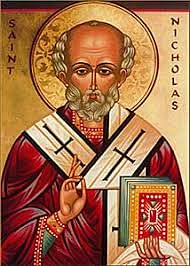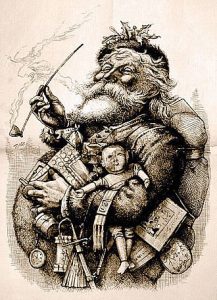Any kid can tell you where Santa Claus is from—the North Pole. But his historical journey is even longer and more fantastic than his annual, one-night circumnavigation of the globe.
The modern American Santa was born in the Mediterranean, evolved across northern Europe, and finally assumed his now-familiar form on the shores of the New World.
The original saint was a Greek born 280 years after Christ . Nicholas was neither fat nor jolly but developed a reputation as a fiery, wiry, and defiant defender of church doctrine during the “Great Persecution,” when Bibles were put to the torch and priests made to renounce Christianity or face execution.

He was imprisoned during the great persecutions under the Roman Emperor Diocletian in A.D. 303 but freed by decree of Emperor Constantine. Thereafter, he served as Bishop in Myra for another thirty years. Nicholas participated in the famous Council of Nicaea in 325. He died on December 6, about 343, and the Feast of St. Nicholas is now held on that day.
Nicholas rose to prominence among the saints because he was the patron of so many groups, ranging from sailors to entire nations. By about 1200, he became known as a patron of children and magical gift bringer because of two great stories from his life.
In the better-known tale, three young girls are saved from a life of prostitution when young Bishop Nicholas secretly delivers three bags of gold to their indebted father, which can be used for their dowries.
The other story Nicholas entered an inn whose keeper had just murdered three boys and pickled their dismembered bodies in basement barrels. The bishop not only sensed the crime, but resurrected the victims as well. “That’s one of the things that made him the patron saint of children.”
He seems to have been adopted by the Netherlands as the patron saint of children, and there, on St. Nicholas Eve, they leave their wooden shoes, or sabots, filled with hay for the Saint’s white horse. He is real to children the world over, under various names as Kris Kringle, La Befana, Yule Tomten, and Christkindli.
 But in early America Christmas wasn’t much like the modern holiday. The holiday was shunned in New England, and elsewhere it had become a bit like the pagan Saturnalia that once occupied its place on the calendar. .
But in early America Christmas wasn’t much like the modern holiday. The holiday was shunned in New England, and elsewhere it had become a bit like the pagan Saturnalia that once occupied its place on the calendar. .
Then, during the early decades of the 19th century, all that changed thanks to a series of poets and writers who strove to make Christmas a family celebration—by reviving and remaking St. Nicholas.
In 1822 Clement Clarke Moore wrote “A Visit From St. Nicholas,” also known as “The Night Before Christmas,” for his six children, with no intention of adding to the fledgling Santa Claus phenomenon. It was published anonymously the next year, and to this day the plump, jolly Santa described therein rides a sleigh driven by eight familiar reindeer.
During the Christmas season of 1862, Thomas Nast, the cartoonist, drew a picture of Santa Claus for Harper’s Weekly at the time of the Civil War. Nast combined his own native German traditions of Saint Nicholas with other German folk traditions of elves in creating the image. His various pictures of Santa Claus ran through 1866, firmly cementing the image in the American mind. The name Santa Claus also became more familiar to American ears than the German Sankt Niklaus or Dutch Sinterklaas. Finally, in the 1930s that the now-familiar American Santa image solidified. The artist Haddon Sundblom began Coca-Cola Santa advertisements running for thirty-five years which finally established Santa as an icon of contemporary commercial culture. This Santa was not an elf, but a man — jolly, and wearing the now familiar white fir-trimmed red suit.
Finally, in the 1930s that the now-familiar American Santa image solidified. The artist Haddon Sundblom began Coca-Cola Santa advertisements running for thirty-five years which finally established Santa as an icon of contemporary commercial culture. This Santa was not an elf, but a man — jolly, and wearing the now familiar white fir-trimmed red suit.
Merry Christmas!



